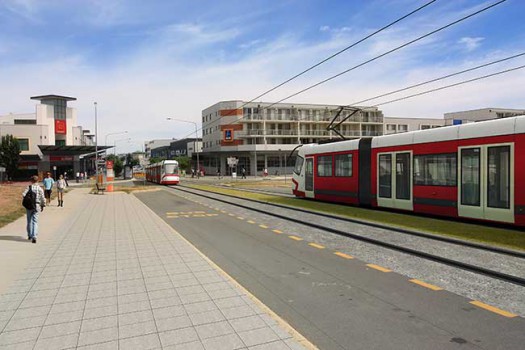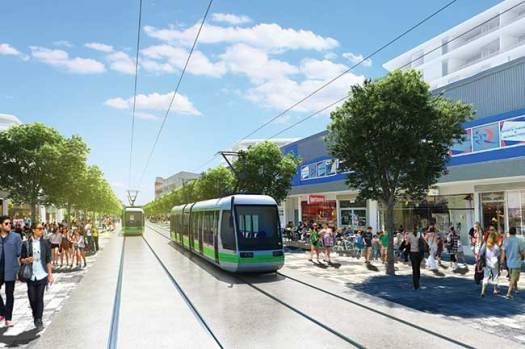
By Paul Hemsley and Julian Bajkowski
Australia’s metropolitan revival of light rail and tramways is showing no sign of slowing down soon.
As the nation’s capital, Canberra, finally makes tentative progress towards installing one of the tramways conspicuously drawn into the designer city’s original masterplan by Walter Burley Griffin a century ago, Melbourne this week started test driving trams the size of a small train.
At 33 metres long and 2.65 metres wide, Melbourne’s new jumbo-size light rail vehicles from Bombardier carry 210 people, or roughly four times the capacity of most busses, and will ply the grid-lined city’s more heavily patronised runs.
Melbourne’s latest trams – of which 50 are provisionally planned – are so long that new parking provisions flagged for St Kilda’s iconic Acland Street to give it space have some shopkeepers up in arms over the sacrifice of parking spaces required make room for stops on its run.
It’s a problem that increasingly congested Canberra can so far only dream of as it goes through the long and necessary process of community consultation to entice more people to commute from the suburbs on public transport.
So far, survey run by the Australian Capital Territory government has reckoned that the public appears eager to use light rail as its preferred public transport option.
It says it has received generally “positive” and “constructive” comments from over 370 Canberra residents who have taken a Light Rail Integration Study online survey.
This survey was set up to identify and assess options for integrating the proposed light rail run from the recently built satellite city of Gungahlin in Canberra’s north with the city’s wider transport network.
The thought of commuting to work (or getting anywhere) without a car in Canberra is a relative novelty for most Canberra residents once generally able to access free but increasingly crowded parking around public service offices.
That concession was halted in the final Budget of the Labor government after the federal National Capital Authority was ordered to instigate pay parking within the Parliamentary Triangle to generate $73 million a year in revenue.
The Abbott government has so far given no indication it will repeal pay-parking on federally controlled land, opting instead to ease competition for car spots by eliminating 12,000 jobs from the Australian Public Service a strategy that most locals remain deeply ambivalent about.
Canberran loathing for pay parking has been compounded by Territory and Federal Budget demarcation lines that mean none of the forecast $73 million in small change shaken out of local pockets will be directly reinvested into improved public transport infrastructure.
According to a spokesperson for Capital Metro, the local government body overseeing transport, light rail is largely viewed as good for Canberra by the online respondents so far.
More than 70 per cent of survey respondents indicated that they are more likely catch a light rail service than the existing ‘Red Rapid’ bus service on the Gungahlin to city route.
The survey also indicated that half of the respondents would walk 800 metres or more to a light rail stop and that majority prefer faster travel speeds with fewer stops instead than having more stops to increase accessibility.
Respondents rated good integration with the bus network as s “very important” and strong integration with the cycling network is similarly supported, with bike parking at light rail stops and the ability to take bikes on the light rail vehicles.
Many of Canberra’s existing busses already have bike rack attached to the front of them to accommodate hybrid commuters.
Actually knowing when the next tram is (really) coming is also a big incentive to get on board in a city where morning temperatures can be close to or below 0 degrees centigrade on winter mornings and evenings
“Real time passenger information is seen as one of the most important facilities to have at light rail stops,” the Metro spokesperson said.
If the ACT government’s plan for light rail is finally realised, it will join Sydney, Perth, Adelaide and the Gold Coast in their recently unveiled plans to create similar transport infrastructure in their own cities.
Melbourne and Sydney have also enabled relatively long running tram and light rail services – the latter of which recently suffered an outage that lasted for three weeks due to two simultaneous derailments.
The consultation period of the ACT government’s survey began on 25th September 2013 and is scheduled to finish on 15th November 2013.
A summary report from the consultation will be made publicly available.
Comment below to have your say on this story.
If you have a news story or tip-off, get in touch at editorial@governmentnews.com.au.
Sign up to the Government News newsletter


Sydney’s derailment did not occur because of the mode choice. No one is quite sure why it happened (twice, twenty minutes apart) but there are two theories on the hop right now, one is because of what was going on around the stations in the way of new development… Apparently an embankment holding the track had moved due to some ridiculously close apartments being built and the earthworks this involved (yes, every piece of land soars in value when the train comes to town – even when it’s not the best place to put housing) and the other theory suggests it happened because certain sections of track had been replaced, but weren’t ground down as is supposed to be standard practice – and this wore down the wheels, making the carriage leave its tracks.
It had to be caused by something like that, because this is the first time derailments have occurred with Sydney’s modern trams since they started operating many years ago.
Beyond that, the mode offers one of the smoothest, quietest rides in town, and is highly appreciated by those who use it. Replacement buses however, took twice as long to deliver people to the city for the three week they were needed.
YES we do need trams in Canberra it should go further like up to Russel and then to Barton has to be longer to get more people to pay for it do a good first not 1/2 job sick of Mr mark parton siring up people to get more ratings